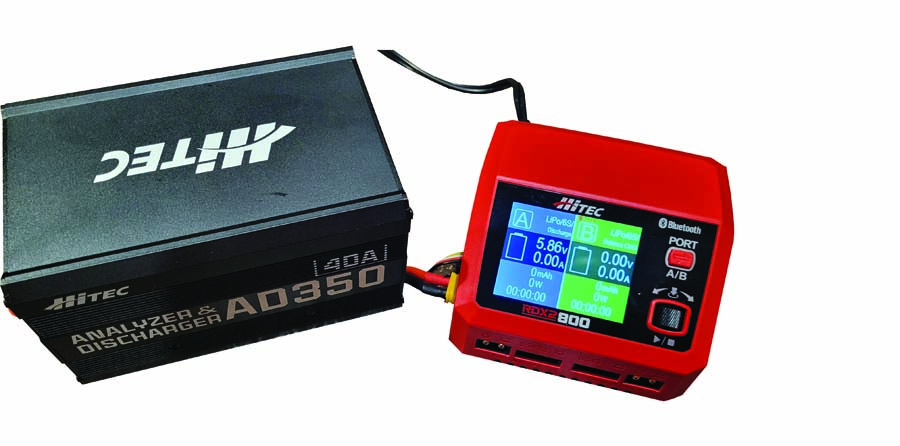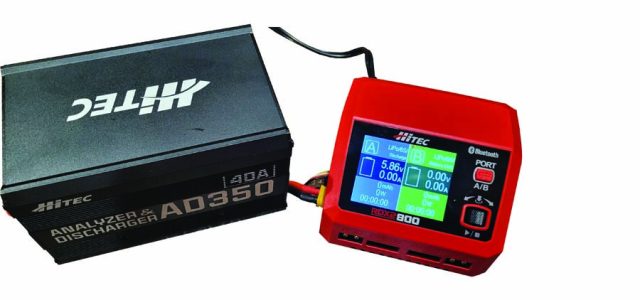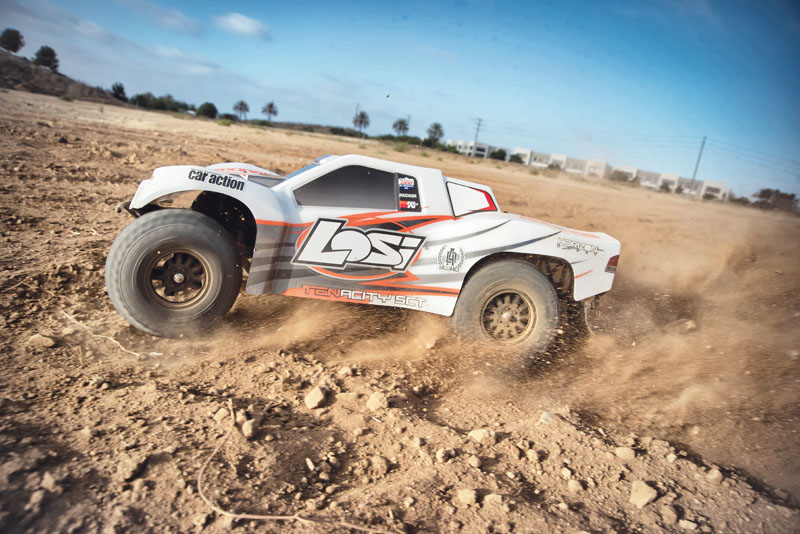Anyone driving a variety of vehicles needs to have a good charger on hand that can handle a variety of battery chemistries and cell counts. Also, you want a charger that pushes enough watts to charge large packs in a timely manner, unless you want to spend your precious time at the track waiting on batteries to finish charging!
Enter the Hitec RDX2 800 multi-chemistry dual-channel charger. The RDX2 800 is chock-full of features that enable maximum flexibility. It will take either a standard 110-volt AC input or a 12- to 24-volt DC input and includes the proper cables for both. Plug it into the wall, or for even more punch connect it to a dedicated DC power supply. This is great for tracks that have 12-volt battery power stations that are charged by solar panels or facilities that provide 12-volt server power supplies.
Features
This small powerhouse will charge up to 6S LiPo batteries at 200 watts on AC power on a single port with “Smart Power Distribution,” meaning it will divide the power between the ports as needed. On DC power the maximum is 400 watts per port, but a whopping 800 watts at 35 amps in parallel. It will also charge lithium ion, LiFe, Ni-Cd, NiMH, and even the new HV LiPo batteries. Like I said, it’s flexible.
The charger output consists of a pair of XT60 connectors along with a matching pair of 2S to 6S balance connectors. An additional charge cable is included to connect both ports in parallel to allow charging from 20 to 35 amps.
Aside from all the functionality that we expect from our chargers, the RDX2 800 offers integrated Bluetooth technology along with Google Play app store software called Hitec Link Power-X. I’m all about playing with tech, so I figured it was neat to start my charger from my phone… but after having the charger in the field for a weekend I realized it’s so much more. I can set one or two batteries to charge, go about my business, and get a push alert on my phone when a battery is done charging. If I’m out on the racetrack in a noisy environment where I can’t hear the beeps, or when there’s a bunch of other people charging, I don’t have to check my charger every time I hear a beep. Cool stuff!
There’s a quick-start guide included, and a full PDF manual is available for download online. But unless you want to get deep into the weeds, the RDX2 800 took me about two minutes of tinkering to figure out how to charge, storage-charge or discharge my LiPo batteries. Also, despite the high charge currents the charger is capable of, it’s very quiet, so I can charge batteries in hotel rooms and still hear the television.
The RDX2 800 will be a regular addition to my pack out when heading to the racetrack. As a bonus, the provided USB interface outlet can be used to recharge my phone if it dies in the field!

Screen shot of the Hitec app on my smartphone; shown is the charging cycle. It also sends a handy push alert when the charge or whatever function you are running is completed.

An example of the discharge curve generated by the AD350 cycler as shown on the Hitec phone app.

Battery level, charge current, mAh consumed are all shown on the screen while the charging cycle is in progress. The scroll wheel doubles as a push button and is very easy to use to navigate the menus.
AD350 Analyzer & Discharger
In addition to the RDX2 800, I also received an AD350 Analyzer and Discharger. This cool tool connects to the RDX2 800 or the RDX2 1000 battery chargers and makes for an extremely powerful combination. When coupled with the Charge Manager software available from Hitec, you have a gold mine of information available at your fingertips.
The RDX2 800 has a USB interface that will connect to a computer running the Charge Manager software. From there you can not only control the charger but use the AD350 to discharge and cycle LiPo and nickel batteries. The software will plot a discharge curve, store settings and allow you to analyze and compare results. This data will tell you when your packs are degrading over time and when it’s time to replace a battery versus replacing an entire system because you were driving it with a bad battery and were unaware.
While the RDX chargers will discharge batteries, the AD350 can safely dissipate much higher current loads of 350 watts (up to a whopping 40 amps) and includes temperature over- protection and an automatic fan. By comparison, the charger alone can only discharge at 10 watts, so discharging packs to test or to storage voltage is a magnitude faster.
FINAL WORD
Don’t let all the geek talk deter you: Both the charger and discharger work perfectly well without being connected to a phone or PC. The charger is easy and intuitive to use, and even if you don’t make use of the computer interface, the AD350 still allows you to discharge or cycle batteries quickly.

Hitec AD350
Analyzer and Discharger
MSRP: $129.99
Hitec RDX2 800
MSRP: $169.99
hitecrcd.com
RC Products Tested & Evaluated
Text and Images by Andrew Griffith








![RC Car Action - RC Cars & Trucks | This 1/3 scale 125cc V10 Buggy is CRAZY [VIDEO]](https://www.rccaraction.com/wp-content/uploads/2018/05/V10-HP.jpg)


 Stay up to date with the latest information, sign up for our FREE newsletter today.
Stay up to date with the latest information, sign up for our FREE newsletter today.
